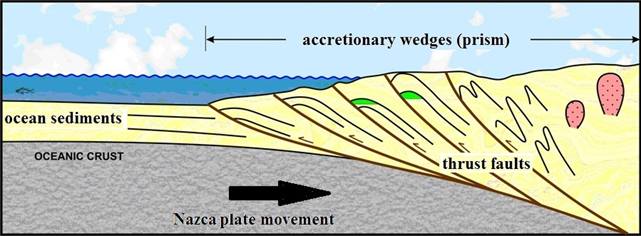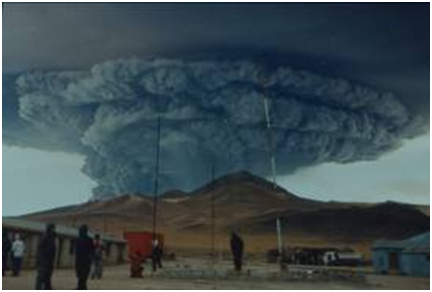The Nazca Plate is moving eastwards, towards the South American Plate, at about 79mm per year.
Where the two plates meet, the denser oceanic lithosphere of the Nazca Plate is forced down and under the more buoyant continental lithosphere of the South American Plate, descending at an angle into the mantle in a process called subduction. This is marked on the ocean surface by the presence of the Peru-Chile (or Atacama) Trench.
The friction between the plates prevents the subducting oceanic plate from sliding smoothly. As it descends, it drags against the overlying plate, causing both to fracture and deform. This results in frequent shallow focus earthquakes that get deeperas the ocean plate descends further, defining a zone of earthquake foci known as a Benioff zone.
As subduction of the Nazca Plate continues, some of the sediments that accumulated on the ocean floor (together with some of the ocean crust) are scraped off and forced (accreted) onto the South American Plate in a process called “obduction”. This forms an accretionary wedge (or ‘prism’), where layers of the deformed and metamorphosed sediments and ocean crust are thrust onto the South American Plate along faults – or thrust planes – adding to the size of the continent.

Cross section of an accretionary wedge
Image: From www.searchanddiscovery.com ‘Deepwater Fold-Thrust Belts: Not All the Beasts Are Equal’, Ana Krueger and Ed Gilbert, 2009
The effect of the collision of the two plates deforms the leading edge of the South American Plate by folding the rocks. This crustal shortening increases the vertical thickness whilst reducing the width of the lithosphere in the collision zone (imagine a car hitting a solid wall) and so produces the fold mountains of the Andes.
Continued subduction of the Nazca Plate brings sea water, locked in the ocean crust, deep into the mantle. As the plate heats up the water is liberated, lowering the melting point of the mantle and causing partial melting. This produces magma, which rises and may be erupted explosively as andesite at the surface.
Andesitic magma is less dense than the surrounding material, and can have a temperature of 1000oC. It is viscous, trapping gases as it rises. The water and gases in andesitic magma account for the explosive activity of andesitic volcanoes, which typically lie dormant for many hundreds or thousands of years. These volcanoes typically produce ash and pyroclastic flows, as well as small amounts of andesitic lava.
Andean volcanoes such as the stratovolcano Láscar, in northern Chile, are a good example of this type of activity. Láscar erupted ash and pyroclastic flows in 1993 and was still active in 2012.

Lascar eruption in 1993